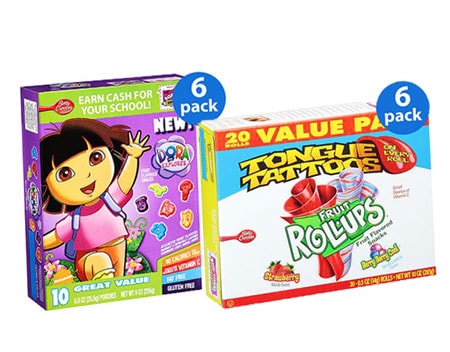
Written By: Owennie Lee, RD
Title: Registered Dietitian
Alumni: University of British Columbia
Last Updated on:

As I was strolling down the grocery aisle, I noticed a plethora of fruit snacks taking up a good portion of the shelf. They all come in colorful and cheerful packaging – promising delicious “real fruits” in convenient packages. I couldn’t help but wonder, how much real fruit is in these snacks, and how healthy and nutritious are they, really?

Table of Contents
Made with pureed fruits (plus other ingredients) and molded into different shapes – strips, rolls, twists, bites, etc. – these “fruit snacks” are trying to pass as real fruits in convenient packages. While a few exceptions truly do contain nothing but fruit purees and fruit concentrate, and offer 4 grams of fiber per bar (e.g., JustFruit Bars by FruitFast), most fruit snacks can’t say the same.
Take General Mills’ Fruit Strawberry Roll-Ups, for example. Not only do they contain corn syrup, dried corn syrup, and sugar (which are all sources of sugar!), but you will also find other unappetizing ingredients such as hydrogenated cotton seed oil and artificial color (red 40, yellows 5 & 6, and blue 1). Ironically, the two things that this fruit roll-up does not contain are strawberries in any form and fiber. Does that sound like a healthy fruit snack for you or your child? Think again!
Many of these “fruit-flavored snacks” are packaged in fun, colorful boxes bearing well-known cartoon characters to lure unsuspecting kids and parents. Containing added sugar, absolutely no fiber, and ingredients such as corn syrup, glucose-fructose (high-fructose corn syrup), modified coconut oil, artificial color and flavor, waxes, etc., these are nothing more than fruit-flavored gummies or candies! It is simply wrong that these are found next to granola bars rather than in the candy aisle, where they truly belong.
The organic fruit-flavored snacks must be better, though, right? Let’s look at Betty Crocker’s “Fruit Flavor Shapes – Go Diego Go! Organic.” It has organic tapioca syrup, organic cane syrup, organic tapioca syrup solids, organic apple juice concentrate, organic grape juice concentrate (all of which mean sugar, essentially), plus non-organic additives such as “natural flavor,” sodium citrate, and wax. Doesn’t sound too wholesome to me!
Canned fruits, when chosen carefully, can be a delicious and convenient way to enjoy fruits. When choosing canned fruits, select fruits canned in 100% fruit juice or water rather than syrup.
Some companies make a variety of canned-fruit products. While some are simply fruit pieces in fruit juice, others (e.g., Dole’s Fruit Bowls in Gels and Fruit Crisps) resemble more of a dessert.
Obviously, the best fruit snack is the real fruit itself, whether it is in its fresh or dried form. By consuming the fruit in its entirety, you are getting all the nutrients and flavor the fruit has to offer. If you are looking for variety beyond the portable apple, banana, orange, etc., dried fruits can help you add to your daily fruit servings easily (¼ cup dried fruit equals 1 serving of fruit). Ordinary dried fruits, such as raisins, dried apricots, prunes, dates, figs, cherries, and bananas, are dried in heat (e.g., in open air under the sun). The flavor is different from their fresh counterparts, and they are often chewier in texture. On the other hand, freeze-dried fruits are made using a flash-freezing process, which preserves the fruit’s original taste, texture and nutrients. However, the downside of freeze-dried fruit is that it tends to be more expensive and absorbs moisture quickly and becomes soggy when exposed to air.
Make sure you choose dried and freeze-dried fruits those that do not contain added sugar or flavoring. For example, Crispy Green has 2 lines of freeze-dried fruits – one that does not contain added sugar (“Crispy Green Crispy Apples”) and one (“FruitziO”) that does. Even Ocean Spray Craisins has a line of dried cranberries that are “infused with juices” (e.g., Craisins Pomegranate Juice Infused Dried Cranberries), which has sugar as the second ingredient, and contains pomegranate juice concentrate and “natural flavor.”
Just stick to real fruits, whether fresh, dried (heat or freeze-dried), frozen, or canned. Don’t bother with the other packaged “fruit snacks” that are made from pureed fruits and concentrates, as you will get very little fruit out of them.
Alumni: University of British Columbia – Owennie is a registered dietitian with a soft spot for chocolate and coffee. She is a believer in balance and moderation, and is committed to keeping healthy eating enjoyable and fun. Owennie received her dietetics training in Vancouver, and is a member of Dietitians of Canada and the College of Dietitians of British Columbia. She has experience in a wide variety of settings, such as clinical nutrition, long-term care and outpatient counseling. Owennie has also worked for a community nutrition hotline and participated regularly as a guest radio host, where she enjoyed sharing her passion and knowledge about food and nutrition with people.
canned foods, dried fruits, fruits snacks, healthy snacks, kid's nutrition, sugar